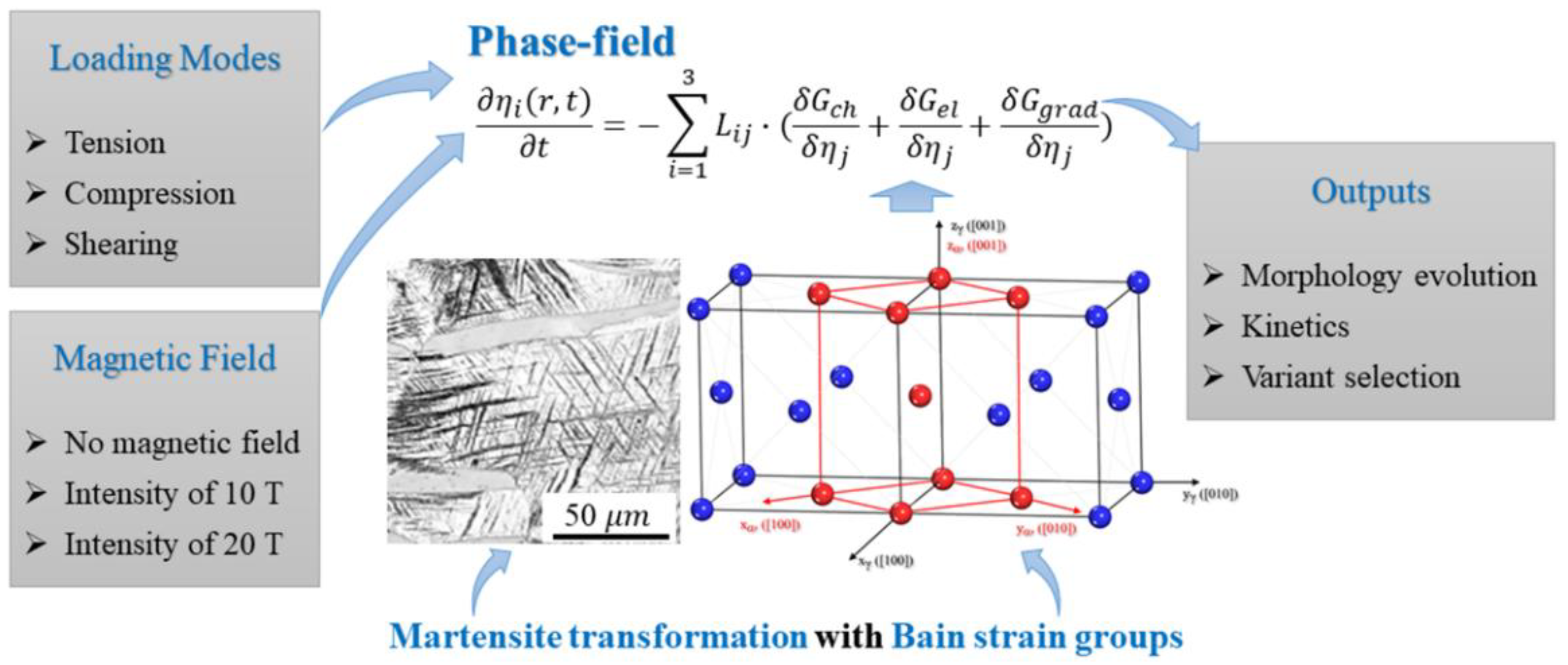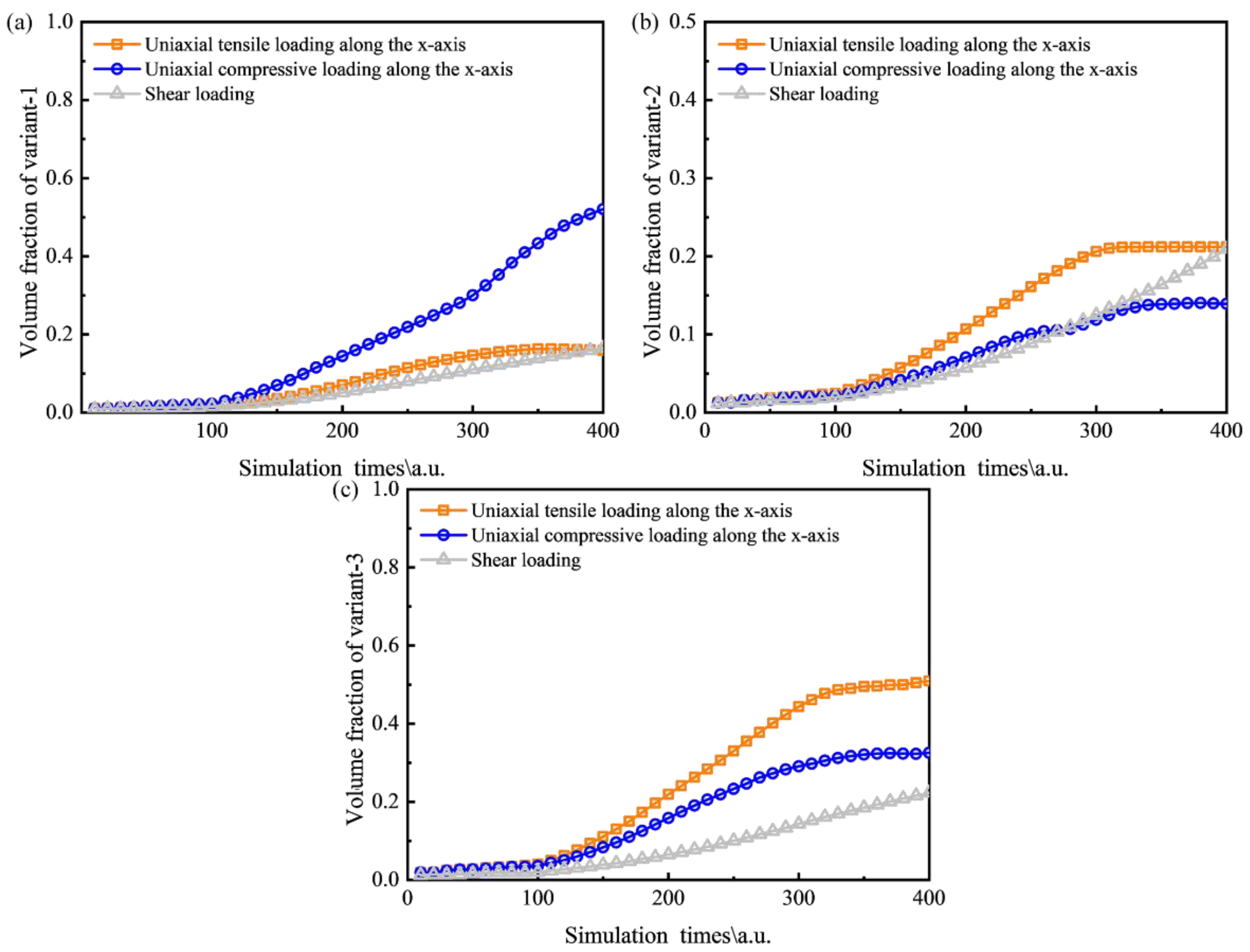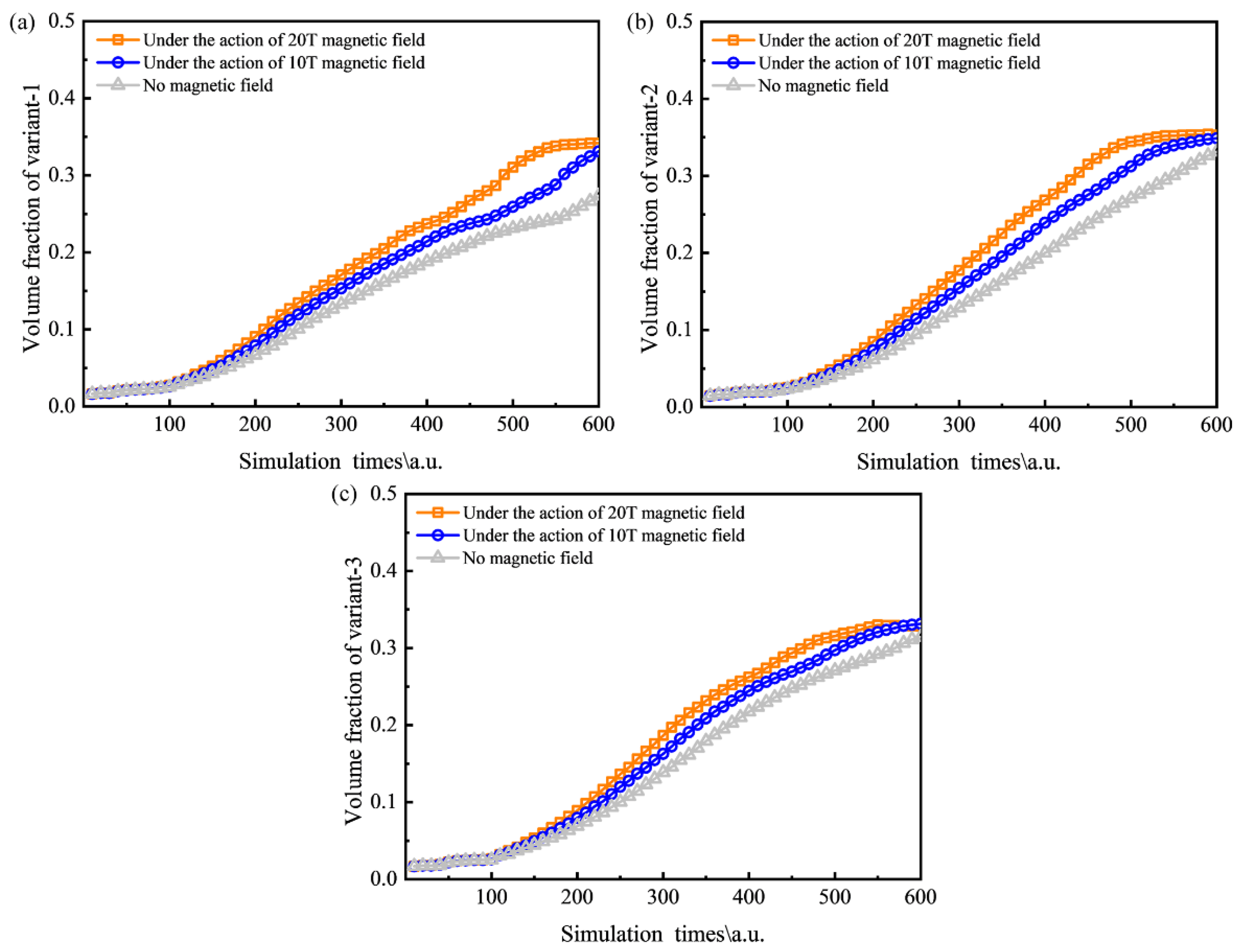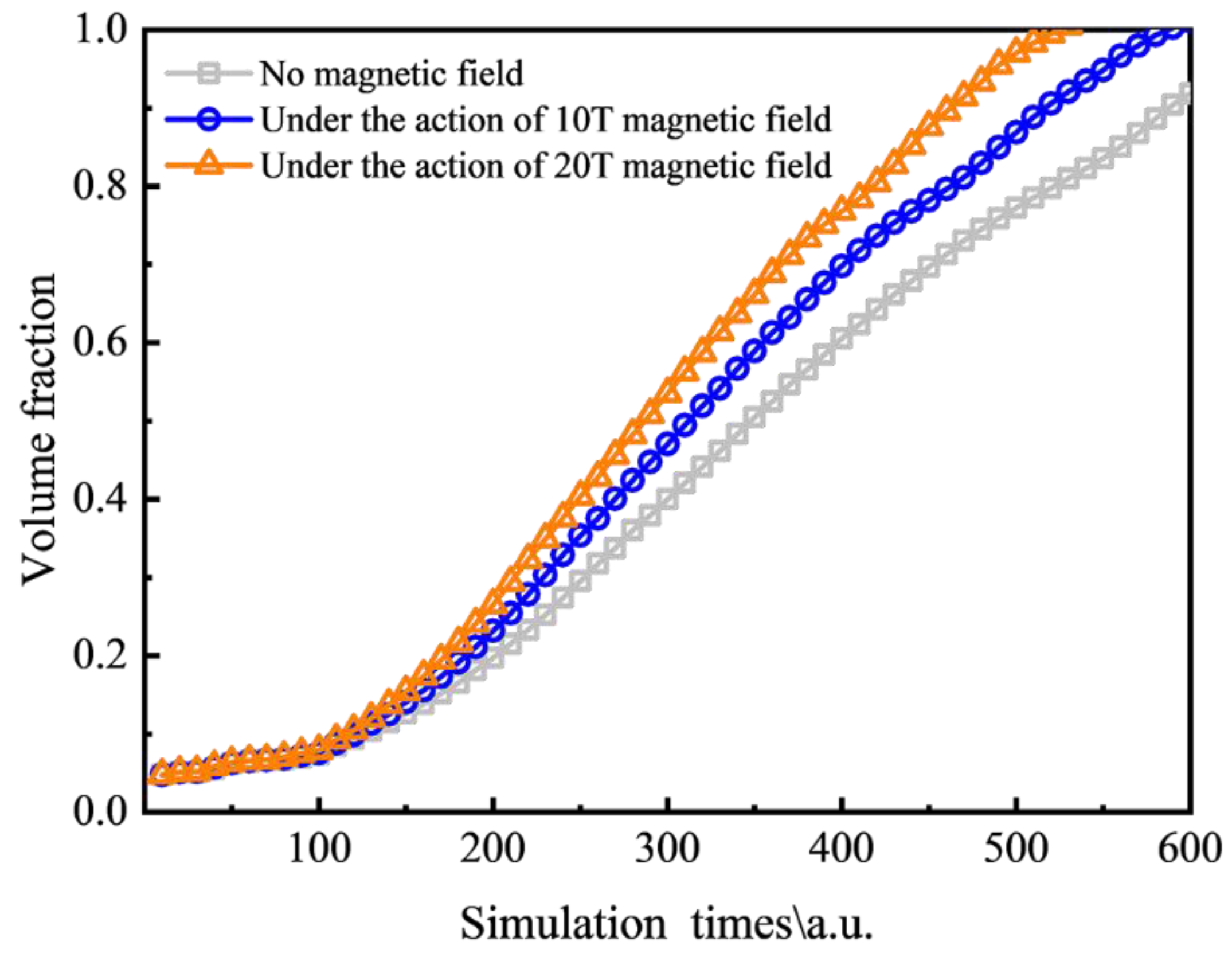Computational Simulation by Phase Field: Martensite Transformation Kinetics and Variant Selection under External Fields
Abstract
:1. Introduction
2. Computational Scheme
3. Results
3.1. Effect of the Loading Mode on Martensite Transformation Behaviour
3.2. Effect of the Magnetic Field on Martensite Transformation Behaviour
4. Discussion
5. Conclusions
- (1)
- Both stress–strain and magnetic fields can accelerate the martensite transformation process and increase the volume fraction of martensite by introducing an additional driving force.
- (2)
- Both uniaxial tension and compression conditions can significantly promote the martensite transformation by significantly increasing the martensite growth rate. However, an obviously preferred variant selection is also observed.
- (3)
- If a relatively large amount of martensite with an unknown preferred variant selection is needed, shearing is probably a better choice because this mode has a relatively balanced stress distribution in different directions compared to those of uniaxial tension and compression conditions.
- (4)
- In addition, if the demand for martensite is relatively small, the magnetic field, which has a relatively low phase transition rate, can be considered. This gentler method is conducive to a more precise control of the martensite volume fraction.
Author Contributions
Funding
Institutional Review Board Statement
Informed Consent Statement
Data Availability Statement
Conflicts of Interest
References
- Wang, M.; Huang, M.X. Abnormal TRIP effect on the work hardening behavior of a quenching and partitioning steel at high strain rate. Acta Mater. 2020, 188, 551–559. [Google Scholar] [CrossRef]
- Josep Roa, J.; Suarez, S.; Guitar, A.; Fargas, G.; Mateo, A. Geometrically necessary dislocations on plastic deformation of polycrystalline TRIP steel. Crystals 2019, 9, 289. [Google Scholar] [CrossRef]
- Qayyum, F.; Guk, S.; Schmidtchen, M.; Kawalla, R.; Prahl, U. Modeling the local deformation and transformation behavior of cast X8CrMnNi16-6-6 TRIP steel and 10% Mg-PSZ composite using a continuum mechanics-based crystal plasticity model. Crystals 2020, 10, 221. [Google Scholar] [CrossRef]
- Schroeder, C.; Wendler, M.; Kreschel, T.; Volkova, O.; Weiss, A. Development of a stainless austenitic nitrogen-alloyed CrMnNiMo spring steel. Crystals 2019, 9, 456. [Google Scholar] [CrossRef]
- Yu, D.; Chen, Y.; Huang, L.; An, K. Tracing phase transformation and lattice evolution in a TRIP sheet steel under high-temperature annealing by real-time in situ neutron diffraction. Crystals 2018, 8, 360. [Google Scholar] [CrossRef]
- Zhao, Y.; Zhao, P.; Li, W.; Kou, S.; Jiang, J.; Mao, X.; Yang, Z. The Microalloying effect of Ce on the mechanical properties of medium entropy bulk metallic glass composites. Crystals 2019, 9, 483. [Google Scholar] [CrossRef]
- Li, Y.; Chen, S.; Wang, C.; San Martin, D.; Xu, W. Modeling retained austenite in Q&P steels accounting for the bainitic transformation and correction of its mismatch on optimal conditions. Acta Mater. 2020, 188, 528–538. [Google Scholar] [CrossRef]
- Seo, E.J.; Cho, L.; De Cooman, B.C. Kinetics of the partitioning of carbon and substitutional alloying elements during quenching and partitioning (Q&P) processing of medium Mn steel. Acta Mater. 2016, 107, 354–365. [Google Scholar] [CrossRef]
- Seo, E.J.; Cho, L.; Estrin, Y.; De Cooman, B.C. Microstructure-mechanical properties relationships for quenching and partitioning (Q&P) processed steel. Acta Mater. 2016, 113, 124–139. [Google Scholar] [CrossRef]
- Kim, J.H.; Park, W.S.; Chun, M.S.; Kim, J.J.; Bae, J.H.; Kim, M.H.; Lee, J.M. Effect of pre-straining on low-temperature mechanical behavior of AISI 304L. Mater. Sci. Eng. A 2012, 543, 50–57. [Google Scholar] [CrossRef]
- Lee, J.M.; Seul-Kee, K. Numerical simulation of membrane of LNG insulation system using user defined material subroutine. J. Comput. Struct. Eng. Inst. Korea 2014, 27, 265–272. [Google Scholar] [CrossRef]
- Kamali, H.; Xie, H.; Bi, H.; Chang, E.; Xu, H.; Yu, H.; Jiang, Z. Deformation mechanism and texture evolution of a low-Ni Cr–Mn–N austenitic stainless steel under bending deformation. Mater. Sci. Eng. A 2021, 804, 140724. [Google Scholar] [CrossRef]
- Kim, H.; Park, J.; Ha, Y.; Kim, W.; Sohn, S.S.; Kim, H.S.; Lee, B.J.; Kim, N.J.; Lee, S. Dynamic tension–compression asymmetry of martensitic transformation in austenitic Fe–(0.4, 1.0)C–18Mn steels for cryogenic applications. Acta Mater. 2015, 96, 37–46. [Google Scholar] [CrossRef]
- Nakada, N.; Ito, H.; Matsuoka, Y.; Tsuchiyama, T.; Takaki, S. Deformation-induced martensitic transformation behavior in cold-rolled and cold-drawn type 316 stainless steels. Acta Mater. 2010, 58, 895–903. [Google Scholar] [CrossRef]
- Sohrabi, M.J.; Naghizadeh, M.; Mirzadeh, H. Deformation-induced martensite in austenitic stainless steels: A review. Arch. Civ. Mech. Eng. 2020, 20, 124. [Google Scholar] [CrossRef]
- Iwamoto, T.; Tsuta, T.; Tomita, Y. Investigation on deformation mode dependence of strain-induced martensitic transformation in trip steels and modelling of transformation kinetics. Int. J. Mech. Sci. 1998, 40, 173–182. [Google Scholar] [CrossRef]
- Xu, Y.; Zhang, S.; Song, H.; Cheng, M.; Zhang, H. The enhancement of transformation induced plasticity effect on austenitic stainless steels by cyclic tensile loading and unloading. Mater. Lett. 2011, 65, 1545–1547. [Google Scholar] [CrossRef]
- Yi, S.; Gao, S.; Shen, L.X. Fracture toughening mechanism of shape memory alloys under mixed-mode loading due to martensite transformation. Inter. J. Solids Struct. 2001, 38, 4463–4476. [Google Scholar] [CrossRef]
- Wang, J.; Wang, C.; Huang, M.; Hu, J.; Xu, W. The effects and mechanisms of pre-deformation with low strain on temperature-induced martensitic transformation. Acta Metal. Sin. 2021, 57, 575–585. [Google Scholar] [CrossRef]
- Suru, M.G.; Morosanu, C.; Bujoreanu, L.G. Variation tendencies of shape memory alloys surface relief as a function of training-cycling parameters. J. Optoelectron. Adv. M 2014, 16, 394–400. [Google Scholar] [CrossRef]
- Jiahua, Y.; Qiuhong, Z.; Jinliang, W.; Chenchong, W.; Wei, X. Synergistic effect of magnetic field and grain size on martensite nucleation and variant selection. Acta Metall. Sin. 2022. [Google Scholar] [CrossRef]
- Karaca, H.E.; Basaran, B.; Karaman, I.; Chumlyakov, Y.I. Stress-induced martensite to austenite phase transformation in Ni2MnGa magnetic shape memory alloys. Smart Mater. Struct. 2012, 21, 045011. [Google Scholar] [CrossRef]
- Schastlivtsev, V.M.; Kaletina, Y.V.; Fokina, E.A.; Yakovleva, I.L. Electron-microscopic examination of martensite crystals nucleated in the N24G4 steel under the action of a DC magnetic field. Fizika Metallov i Metallovedenie 2003, 95, 68–77. [Google Scholar]
- Fei, H.; Hedstrom, P.; Hoglund, L.; Borgenstam, A. A Thermodynamic-based model to predict the fraction of martensite in steels. Metall. Mater. Trans. A 2016, 47A, 4404–4410. [Google Scholar] [CrossRef]
- Lee, S.J.; Van Tyne, C.J. A kinetics model for martensite transformation in plain carbon and low-alloyed steels. Metall. Mater. Trans. A 2012, 43A, 422–427. [Google Scholar] [CrossRef]
- Mathevon, A.; Massardier, V.; Fabregue, D.; Ollat, M.; Rocabois, P.; Perez, M. Thermodynamic-based model coupled with phase transformation simulation to predict the ms temperature in the case of two-phase steel. Metall. Mater. Trans. A 2022, 53, 1674–1681. [Google Scholar] [CrossRef]
- Artemev, A.; Khachaturyan, A.G. The phase field model and computer simulation of martensitic transformation under applied stresses. Mater. Sci. Forum 2000, 327–328, 347–350. [Google Scholar] [CrossRef]
- Malik, A.; Amberg, G.; Borgenstam, A.; Ågren, J. Effect of external loading on the martensitic transformation—A phase field study. Acta Mater. 2013, 61, 7868–7880. [Google Scholar] [CrossRef]
- Ghosh, G.; Olson, G.B. Kinetics of F.C.C. → B.C.C. heterogeneous martensitic nucleation—I. The critical driving force for athermal nucleation. Acta Metall. 1994, 42, 3361–3370. [Google Scholar] [CrossRef]
- Ghosh, G.; Olson, G.B. Kinetics of F.c.c. → b.c.c. heterogeneous martensitic nucleation—II. Thermal activation. Acta Metall. 1994, 42, 3371–3379. [Google Scholar] [CrossRef]
- Li, C.; Gao, J.; Zhang, D.; Chen, Z.; Han, X. Influence of material parameters on 2D-martensitic transformation based on the phase-field finite-element method. Metall. Res. Technol. 2019, 116, 614. [Google Scholar] [CrossRef]
- Yeddu, H.K.; Lookman, T.; Saxena, A. The simultaneous occurrence of martensitic transformation and reversion of martensite. Mater. Sci. Eng. A 2014, 594, 48–51. [Google Scholar] [CrossRef]
- Ahluwalia, R.; Mikula, J.; Laskowski, R.; Quek, S.S. Phase field simulation of martensitic-transformation-induced plasticity in steel. Phys. Rev. Mater. 2020, 4, 103607. [Google Scholar] [CrossRef]
- Basaka, A.; Levitas, V.I. Matrix-precipitate interface-induced martensitic transformation within nanoscale phase field approach: Effect of energy and dimensionless interface width. Acta Mater. 2020, 189, 255–265. [Google Scholar] [CrossRef]
- Kundin, J.; Raab, D.; Emmerich, H. A phase-field model for incoherent martensitic transformations including plastic accommodation processes in the austenite. J. Mech. Phys. Solids 2021, 59, 2082–2102. [Google Scholar] [CrossRef]
- Song, P.; Ji, Y.; Chen, L.; Liu, W.; Zhang, C.; Chen, L.Q.; Yang, Z. Phase-field simulation of austenite growth behavior: Insights into the austenite memory phenomenon. Comp. Mater. Sci. 2016, 117, 139–150. [Google Scholar] [CrossRef]
- Shchyglo, O.; Du, G.; Engels, J.K.; Steinbach, I. Phase-field simulation of martensite microstructure in low-carbon steel. Acta Mater. 2019, 175, 415–425. [Google Scholar] [CrossRef]
- San Martín, D.; Aarts, K.W.P.; Rivera-Díaz-del-Castillo, P.E.J.; van Dijk, N.H.; Brück, E.; van der Zwaag, S. Isothermal martensitic transformation in a 12Cr–9Ni–4Mo–2Cu stainless steel in applied magnetic fields. J. Magn. Magn. Mater. 2008, 320, 1722–1728. [Google Scholar] [CrossRef]
- Martin, D.S.; van Dijk, N.H.; Brück, E.; van der Zwaag, S. The isothermal martensite formation in a maraging steel: A magnetic study. Mater. Sci. Eng. A 2008, 481–482, 757–761. [Google Scholar] [CrossRef]
- Malik, A.; Yeddu, H.K.; Amberg, G.; Borgenstam, A.; Ågren, J. Three dimensional elasto-plastic phase field simulation of martensitic transformation in polycrystal. Mater. Sci. Eng. A 2012, 556, 221–232. [Google Scholar] [CrossRef]
- Tsuchida, N.; Tomota, Y. A micromechanic modeling for transformation induced plasticity in steels. Mater. Sci. Eng. A 2000, 285, 345–352. [Google Scholar] [CrossRef]







| Parameters | Values | Parameters | Values |
|---|---|---|---|
| 0.1 | * | 0.35 | |
| 5.0 | |||
| 5.0 | |||
| 429 K |
Publisher’s Note: MDPI stays neutral with regard to jurisdictional claims in published maps and institutional affiliations. |
© 2022 by the authors. Licensee MDPI, Basel, Switzerland. This article is an open access article distributed under the terms and conditions of the Creative Commons Attribution (CC BY) license (https://creativecommons.org/licenses/by/4.0/).
Share and Cite
Wang, C.; Yuan, J.; Huang, M. Computational Simulation by Phase Field: Martensite Transformation Kinetics and Variant Selection under External Fields. Crystals 2022, 12, 829. https://doi.org/10.3390/cryst12060829
Wang C, Yuan J, Huang M. Computational Simulation by Phase Field: Martensite Transformation Kinetics and Variant Selection under External Fields. Crystals. 2022; 12(6):829. https://doi.org/10.3390/cryst12060829
Chicago/Turabian StyleWang, Chenchong, Jiahua Yuan, and Minghao Huang. 2022. "Computational Simulation by Phase Field: Martensite Transformation Kinetics and Variant Selection under External Fields" Crystals 12, no. 6: 829. https://doi.org/10.3390/cryst12060829





